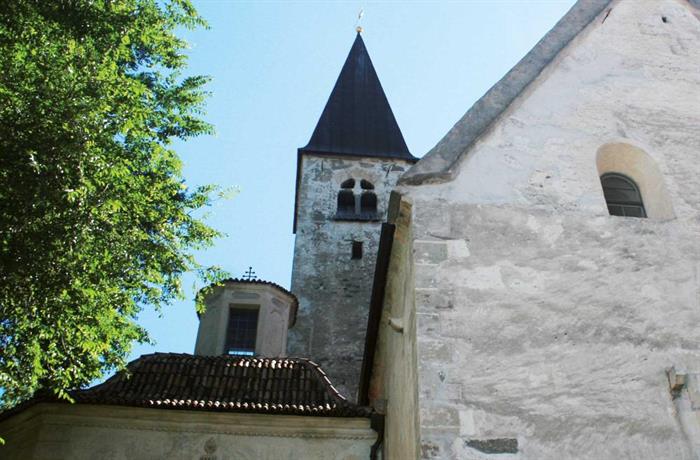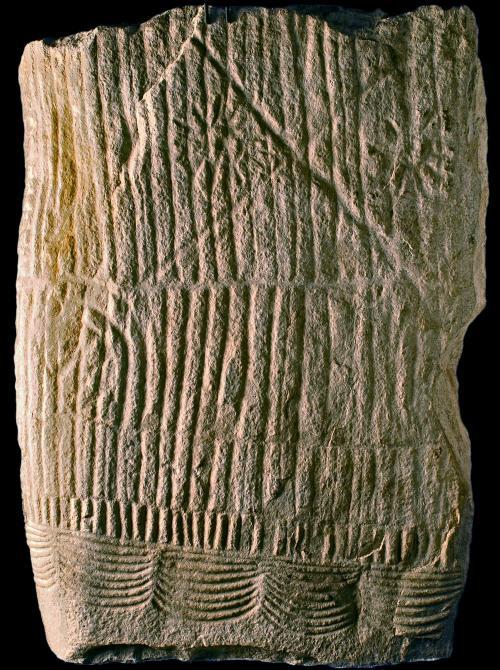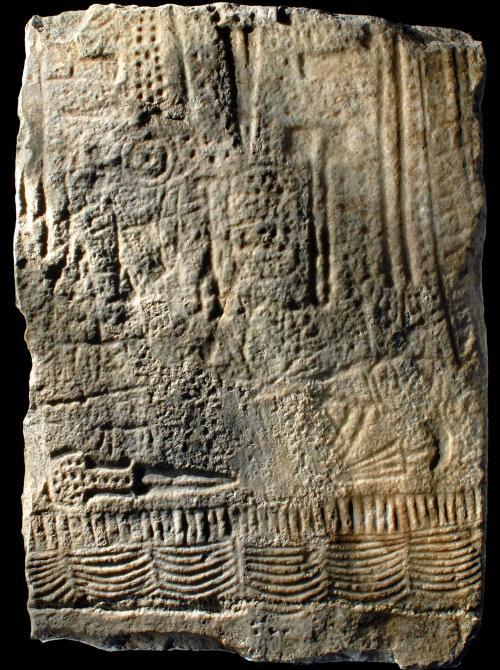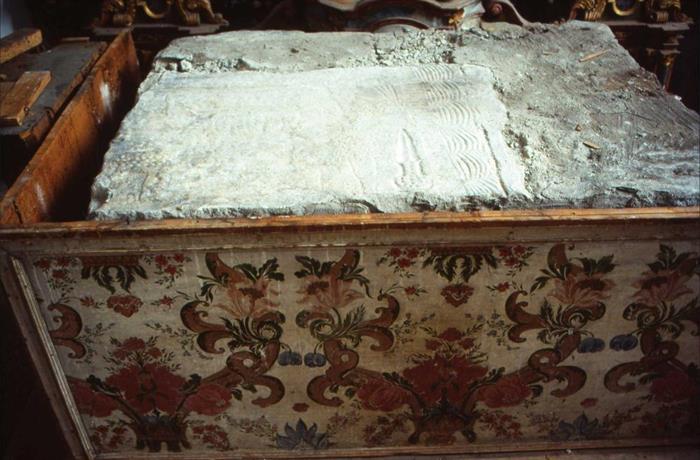La straordinaria storia del reperto // The extraordinary history of the find
Il menhir trovato nella chiesa Santa Maria in Colle è uno dei reperti archeologici più importanti di Laces. Nel luglio 1991 l’allora ispettore per la Val Venosta dell’Ufficio Beni archeologici Dr. Hans Nothdurfter accompagnò i lavori di restauro della torre e della chiesa. L’altare particolarmente suscitò l‘interesse dell‘archeologo: Nell’età barocca l’altare gotico fu rivestito con legno su tutte le parti. La lastra d’altare di legno aveva un‘apertura di ca. 40 x 40 cm per un reliquiario in forma di una lastra di pietra quadrata. In quest’apertura si vedevano una cintura in forma di ghirlanda e un pugnale di un menhir la cui importanza fu subito riconosciuta. Quando si rimosse il rivestimento in legno dell’altare gotico, apparve tutto il menhir di marmo di Lasa. In presenza di numerosi scienziati e dei media la lastra fu sollevata dalla mensa dell'altare rivelando per la prima volta anche il lato posteriore. L’importante reperto dell’età del rame è stato scoperto quasi un anno dopo la scoperta dell’Uomo venuto dal ghiaccio. Nonostante il fatto che gran parte dei menhir non siano stati trovati sul loro sito originario e che alcuni menhir avessero una funzione nuova al momento del ritrovamento, l’uso come lastra d‘altare rimane singolare. L’originale luogo di ritrovamento di questo menhir non è noto ma si presume che sia stato nelle vicinanze della chiesa Santa Maria in Colle.
The menhir found in the church of Our Dear Lady on the Bichl is among the most important archaeological finds in Laces. In July 1992, Dr. Hans Nothdurfter, then area inspector for Val Venosta of the Department for Archaeological Monuments, was responsible for the restauration of both the tower and the church. The altar particularly wakened the interest of the archaeologist: The Gothic altar got a wood panel on all sides during the Baroque period. The wooden altar stone had an opening of about 40 x 40 cm for the reliquary in the form of a square stone slab. In this opening, you could see a garland-shaped belt and a dagger of a menhir whose importance was immediately understood. When the Baroque panel of the Gothic altar was removed, the whole menhir made of Lasa marble came to light. The altar stone was taken from the altar mensa in the presence of numerous scientists and the media and thus the backside was visible for the first time as well. The important find from the Copper Age came to light almost a year after the discovery of Ötzi the Iceman. Even though the majority of menhirs were not found at their original site and despite the fact that some of them had another function when found, the use as an altar stone remains unique. It is not known where the menhir’s original site was but it is presumed that it was not too far away from the church of Our Dear Lady on the Bichl.

Chiesa Santa Maria in Colle // Church of Our Dear Lady on the Bichl
Qual era la sua forma originale? // What was its original form?
Il menhir fu aggiustato per poter essere messo sulla predella. La sua parte superiore e quella inferiore furono tagliate e non a caso: la parte inferiore ancorata nel terreno in posizione eretta terminava quasi sempre in un cono. La parte superiore invece era ad arco o aveva una specie di testa. Per il suo nuovo uso ci volevano bordi più o meno esatti. Originariamente il menhir aveva una lunghezza di più di 2 m, mentre la lunghezza di oggi è di ca. 1 m.
The menhir was knocked into the necessary dimensions to be positioned on the predella. Both the upper and lower part were knocked off and not just by chance: The lower part, which is anchored in the ground in upright position, normally ends in a conic form. The upper part is arch-shaped or has some kind of head. For its new use, it was necessary to get more or less exact edges. The menhir had an original length of more than 2 m, whereas today’s length is just about 1 m.

Il menhir di Laces // The Laces menhir

Il menhir di Laces // The Laces menhir
A quale età risale il menhir di Laces? // How old is the Laces menhir?
Questo monumento unico risale al periodo tra il tardo 4° e inizio 3° millennio a.C. e quindi all’età del rame come si chiama l’ultimo periodo del periodo litico. È testimonianza di un culto coltivato per generazioni al cui centro probabilmente era una mitologia di antenati ed eroi. Rimane poco chiaro per quali occasioni nuovi oggetti furono inseriti nella raffigurazione. Presumibilmente rappresentano diverse generazioni. Il menhir è un indizio del fatto che il territorio di Laces era il centro religioso e politico di una fascia di popolazione. Si dice che negli anni 70 un altro menhir sia stato trovato a Laces e che sia stato portato all’estero ma non si sanno dettagli sul luogo di ritrovamento o sulla rappresentazione figurativa della pietra.
This unique monument was created between the late 4th and the early 3rd millennium BC and thus during the Copper Age as the last period of the Stone Age is called. It is a testimony of a cult cultivated for generations that was probably centered around an ancestor and hero mythology. It remains unclear for which occasions new objects were again and again inserted in the picture repertoire. They probably represent different generations. The menhir is an indication of the fact that a population group had its religious and political center in and around Laces. It is said that another menhir was found in Laces in the 1970s. It was finally taken abroad but there are no information about the site of the find or the pictorial design of the stone.
I menhir di Silandro // The Silandro menhirs
Alcuni anni fa diversi menhir sono stati trovati sul territorio del comune adiacente di Silandro. Oggi sono esposti a Silandro e possono essere visitati. Per ulteriori informazioni cliccare qui.
Several menhirs were found on the territory of the neighboring municipality of Silandro some years ago. Today, they are exhibited in Silandro and can be visited. More information can be found here.
Che cos’è un menhir? // What is a menhir?
I menhir sono pietre di forma umana erette singolarmente. Queste statue stele sono tra le più importanti opere d’arte ancora preservate della nostra preistoria. Sono note da più di 100 anni, soprattutto nel Mediterraneo e nelle regioni adiacenti. Alla fine del periodo neolitico la scoperta del rame e del bronzo nonché l’espansione del commercio risultano in un rilancio sociale, economico e culturale delle società europee. Sembra svilupparsi una fascia elitaria della popolazione che porta armi, attrezzi di lavoro e gioielli di metallo come simboli del potere. Questi nuovi oggetti sono raffigurati sui menhir assieme ad altri simboli ed ornamenti: Armi ed elementi di gioielli sono rappresentati come spirali. A seconda dei simboli regionalmente diversi si distinguono vari gruppi. Il menhir di Laces nonché dodici altri menhir altoatesini e sette menhir trentini fanno parte del gruppo della Val d’Adige. Si caratterizzano per le loro strisce verticali che possono essere interpretate come la rappresentazione di un mantello a frange. Inoltre le stele maschili spesso hanno un pugnale con lama triangolare (tipo Remedello). Un altro gruppo è il gruppo lombardo della Valcamonica al fiume Oglio e della Valtellina. I menhir appaiono sempre in gruppi, il che potrebbe essere un’indicazione di una famiglia politicamente dominante. Le stele maschili chiaramente superano tutte le altre sia per dimensioni che per decorazione. I menhir dell’età del rame sono testimoni di un pensiero politico e territoriale ed implicano pratiche rituali consolidate e centri religiosi che hanno esistito per molto tempo. Solo in rari casi questi reperti archeologici danno informazioni sulla struttura di questi posti e sui rituali praticati. Normalmente i menhir erano eretti in forma cellulare in una posizione esposta nelle cui vicinanze ci sono testimonianze di pratiche come quelle di accendere un fuoco e fare offerte.
Menhirs are single standing stones in the form of humans. The so-called figure menhirs are among the most important still preserved works of art of our prehistory. They have been known for more than 100 years, especially in the Mediterranean regions and its adjacent areas. At the end of the Neolithic period, the discovery of copper and later bronze as well as the expansion of trade led to a social, economic and cultural revival in European societies. It seems that an elite class of society developed. Its members carried weapons, tools and jewellery made of metal as status symbols. The new objects also appeared on the menhirs together with other symbols and ornaments: Weapons and jewelry elements are represented like spirals. They are divided into different groups due to regionally different symbols. The Laces menhir belongs to the so-called Adige Valley group together with twelve other South Tyrolean menhirs and seven menhirs from Trentino. They all have vertical stripes that are interpreted as the representation of a fringed cloak. Furthermore, the male stales often show a dagger with a triangular blade (Remedello type). Another group is the Lombardic group of Valcamonica at the Oglio river and of Valtellina. Menhirs always appear as a group, which might be an indication of a politically dominant family. Male steles considerably top all the others both in size and decoration. Menhirs from the Copper Age are testimonies of political and territorial thinking and imply that there were firmly established ritual practices as well as religious centers, which had existed for a long time. It's only in very rare cases that these archaeological features give information about the structure of these sites or about practiced rituals. Menhirs were normally arranged in cellular form in an exposed position and nearby, there is proof of lighting a fire and presenting offerings.

Il menhir come lastra d'altare // The menhir as an altar stone
Eroi, dei o antenati? // Heroes, gods or ancestors?
Queste statue sono spesso viste come immagini di dei. Simboli del sole in combinazione con armi raffigurate possono essere interpretate come divinità maschili che nel corso dell’età del rame furono arricchiti di tratti femminili e le cui origini sono nelle dee madri del Neolitico. L'ipotesi contrasta invece assume un forte legame con il culto degli antenati e con l’eroizzazione o la deificazione di un morto eminente. È certo che i menhir rappresentano personalità di alto rango. Ciò si vede dalle armi e da una specie di abito rituale. Rimane invece aperto se singole famiglie sono in qualche modo rappresentate dinasticamente nei gruppi di stele.
Fonte: Hubert Steiner: Latsch in der Urgeschichte, Dorfbuch Latsch
These statues were again and again viewed as god images. Sun symbols in combination with represented weapons could be interpreted as male deities that were supplemented by female traits in the course of the Copper Age and whose origins are in earlier Neolithic mother goddesses. In contrast, there is the hypothesis of a close link to the ancestor worship and the heroization or deification of some outstanding dead people. It is, however, undisputed that menhirs represent high-ranking personalities, which can be seen from the weapons and from some kind of ritual robe. It must, however, remain open if single families are to some extent dynastically represented in the groups of steles.
Source: Hubert Steiner: Latsch in der Urgeschichte, Dorfbuch Latsch